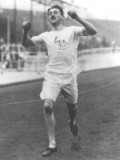|
DOUG GILLON REPORTS IN TODAYS HERALD
Hero from a forsaken generationDOUG GILLON July 21 2008
WYNDHAM HALSWELLE was the first Scot to win an individual Olympic athletics title, 100 years ago this week, in London.
He took 400 metres gold in the only Olympic walkover in history, provoking a diplomatic incident with the USA.
He is among Britain's greatest sports heroes, later giving his life for his country. Young Scots run today for a trophy in his memory, yet his English public school, Charterhouse, recently rejected the offer of his Olympic medals and memorabilia for a commemorative display.
No other British athlete has won a complete set of individual gold, silver, and bronze. His Scottish 440 yards record (48.4) survived the attentions of 1924 Olympic champion Eric Liddell, and was surpassed only in 1958, by John McIsaac.
His UK 440 record lasted until 1934. It was broken by Godfrey Rampling (father of film star Charlotte), an Olympic 4 x 400m gold medallist in 1936. And the Scottish 300 yards record he set in 1908 lasted until 1961, beaten by a Glasgow University student now known as Sir Menzies Campbell.
Halswelle won 400m silver (his only defeat at the distance) and 800m bronze at the 1906 interim Olympics in Athens, the first time the British Olympic Association sent an official team. He was selected for the 100m, 400m, and 800m, a range of events no other GB athlete has since matched.
Most prodigious of all domestically, however, was a sweep of the Scottish 100, 220, 440 and 880 yards titles in one afternoon at Powderhall in 1906. This remains unequalled.
Yet today there is hardly a more eloquent testimony to his athleticism than the remarkable photo above right, from the familiy archive. It was discovered in a chest in the attic, along with Halswelle's Olympic medals. They are now in the posession of his great nephew and namesake, Wyndham Halswelle. Two years ago he accepted his forebear's induction into the Scottish athletics hall of fame. "But Charterhouse weren't the least bit interested when I offered the memorablia for an exhibition this year," he said yesterday.
England, truly a land fit for for heroes to live in.
Halswelle was the son of a noted water-colourist, Keeley Halswelle, and his third wife, Helen Mariana Gordon, daughter of Major General Nathaniel Gordon, who lived near Glasgow.
Wyndham was a decorated Boer War veteran when he lined up as one of four 1908 finalists (three of them American). He'd set an Olympic record of 48.4 in the semi finals, but there were no lanes, and John Carpenter (a second slower than Halswelle in his heat) ran increasingly wide in the home straight, forcing his rival to the edge of the track.
"Halswelle was the victim of very similar tactics in Athens . . . and to prevent anything of that kind on this occasion, officials had been placed at the bends," reported The Glasgow Herald on July 24, 1908. "They signalled a foul, and the finish judge a Scot broke the tape before Carpenter reached it."
With Carpenter disqualified, the other two Americans declined the re-run. US media described Halswelle as: "idol of the British aristocracy" and "favourite toff of the Cockney crowd". Halswelle duly ran round, solo, in 50 seconds flat. The track was rigged with strings - the origin of sprints now being in lanes. The Americans said they had been, "rooked, bilked, cheated, swindled, and robbed".
Subsequently, while serving in France, Halswelle wrote an account of trench warfare at Neuve Chapelle for the HLI regimental magazine. It appeared in the same edition which reported his death, shot by a sniper, in 1915: "I called on the men to get over the parapet," he wrote. "There is great difficulty in getting out of a trench, especially for small men laden with a pack, rifle and perhaps 50 rounds in the pouch, and a bandolier of 50 rounds hung around them, and perhaps four feet of slippery clay perpendicular wall with sandbags on the top.
"I got about three men hit actually on top of the parapet. I made a dash at the parapet and fell back. The Jocks then heaved me up and I jumped into a ditch - an old trench filled with liquid mud - which took me some time to get out of."
His men gained 15 yards, a distance Halswelle the athlete would have covered in less than two seconds. They dug in for over three hours before retreating to where they'd started from. They had lost 79 men.
Days later Halswelle himself was dead, aged 32.
His grave was marked with a wooden cross, with his name in charcoal. Thirty years later, in a wartime Japanese internment camp, the grave of Scotland's next Olympic 400m champion, Liddell, was marked with an identical cross. His name was marked in boot polish.
Halswelle's body was eventually re-interred at Laventie, near Armentieres. There is no mention of athletics feats on his gravestone. Like so many of his generation, Scotland's first Olympic champion disappeared almost without trace.
NOTE FROM ED
John McIsaac was a Glasgow Accie who ran in the colours of Victoria Park AAC
This article was originally posted on 21-Jul-2008, 07:39 by Hugh Barrow.
Last updated by Hugh Barrow on 21-Jul-2008, 12:18.
|

John McIsaac no 50

WYNDHAM HALSWELLE
|









